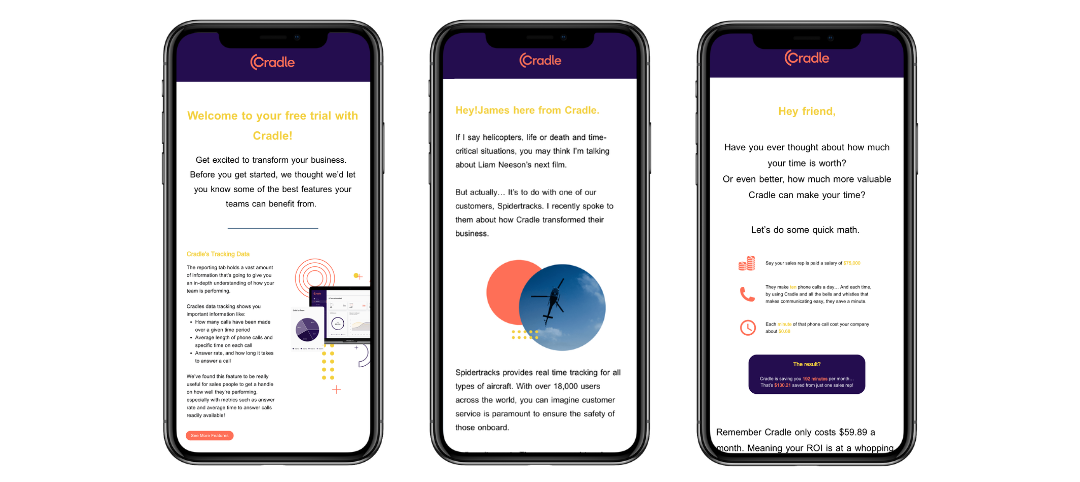The essential 5-step B2B email nurture flow
Email marketing is one of the most effective ways for businesses to nurture leads, retain customers, and build trust and authority.
The Direct Marketing Association conducted a study in which they found that for every $1 spent on email marketing, the average return on investment was $44 - that’s an insane 4,400% ROI, and proves that it’s well worth your time!
If your marketing has done the heavy lifting of convincing someone to give up their email address - they will expect to hear from you! Which is why it is a no-brainer to have a solid email nurture journey flow in place. Don’t waste that golden opportunity to continue the conversation…
An email nurture journey flow is a series of emails that are designed to guide your prospects through the sales funnel by providing valuable content at every stage of their journey, from awareness to decision-making (and sale)!
Here's an essential B2B email nurture journey flow that you can customise to create a successful email marketing campaign:
STEP 1: Welcome email
The welcome email is the first email that a prospect receives after subscribing to your email list, or downloading a piece of content. It's your chance to make a good first impression and set the tone for the rest of the email nurture journey. The welcome email should be personalised and include:
the piece of content they’ve signed up to receive (if that’s what they’ve signed up for)
a brief introduction to yourself and your company, as well as a clear explanation of what subscribers can expect to receive from your emails. It's also a good idea to include a call-to-action (CTA) that encourages subscribers to take an action, such as visiting your website or following you on social media. Nothing too pushy or sales-y at this point.
Step 2: Educational email
Give it a few days, and then the next email in your nurture journey flow should be an educational email that provides value, value, value! This email should be focused on educating your prospect about a specific pain point or problem (that perhaps your product or service can solve). The educational email should not be sales-focused, but rather informative and helpful.
(You could do a few more of these educational emails in between the next step if you have the right type of content).
Step 3: Product/service email
Once you've provided value to your subscribers with an educational email, it's time to introduce them to your product or service. This email should focus on the benefits of your product or service and how it can solve the pain point or problem that you discussed in the previous email. Include a clear CTA that encourages subscribers to learn more about your product or service or to request a demo. If they’ve opened your emails at this point, they probably are interested in learning more.
Step 4: Case study/testimonial email
The case study/testimonial email is an essential part of your email nurture journey flow because it provides social proof and credibility to your product or service. This email should highlight a successful case study or testimonial from a satisfied customer. Include specific details about how your product or service helped solve their problem or pain point. This email should have a clear CTA that encourages your prospect to take action, such as booking a call, requesting a demo, or signing up for a free trial.
Step 5: Follow-up email
After sending the previous emails, it's important to follow up with your prospect to keep them engaged and interested in your product or service. This email should be personalised (it the very least use their name and talk about their business specifically), and include a reference to the previous emails that you’ve sent. You can use this email to answer any questions that subscribers may have or to provide additional information about your product or service. Include a clear CTA that encourages them to take action, such as scheduling a call, or signing up for a free trial.
What if they haven’t taken action after this series? If they’ve opened your emails throughout the journey, they’re still semi-interested, so we recommend adding them into your monthly email database so they hear more from you over time.
If they haven’t opened any of your emails, it’s likely your email never made it to their inbox - possibly gone into the black hole of a spam filter - or they could just be a terrible emailer with a hectic, overflowing inbox… To keep your email deliverability nice and high, you could move these “unengaged” prospects into a list to try and re-engage later.
Conclusion
A successful B2B email nurture journey flow is essential for converting leads into paying customers. By following this essential email nurture journey flow, you can guide your prospects through the sales journey, or at the very least, you’ll add some value along the way and build some trust and rapport.
If the idea of sending emails to your prospects makes you cringe, or makes you feel as though you’re “pestering” people; maybe it’s time to take a look at your content strategy and put in the effort to make some content worth sending! You’re right to respect the inbox, and you should only ever send content you think is going to truly add value.


